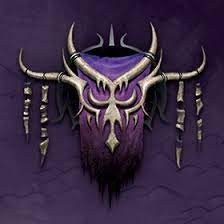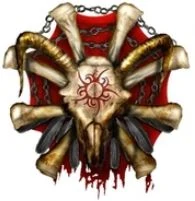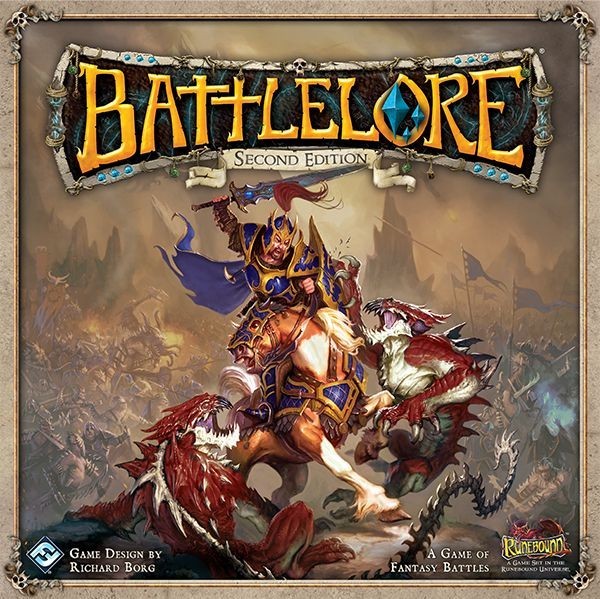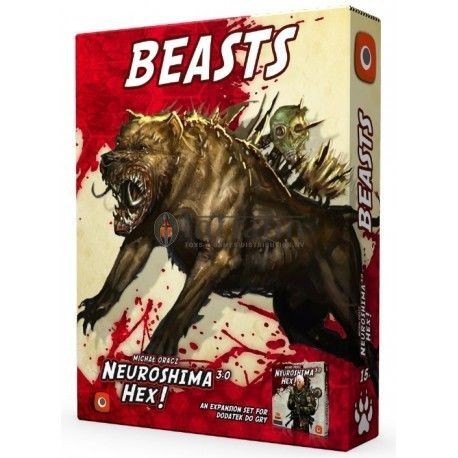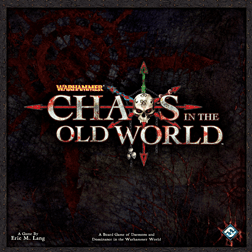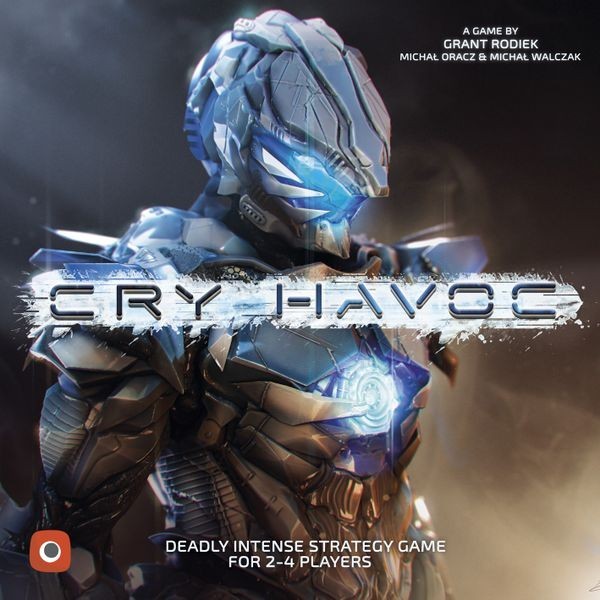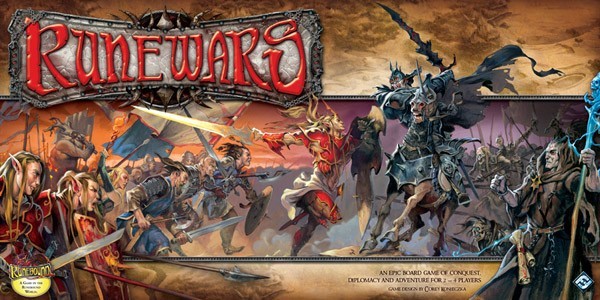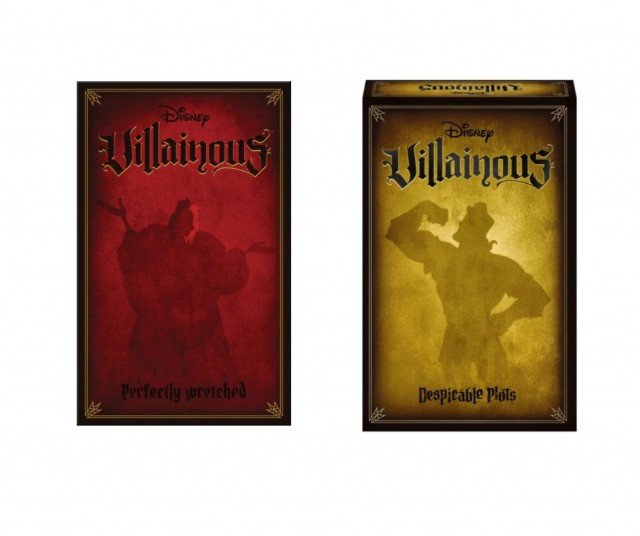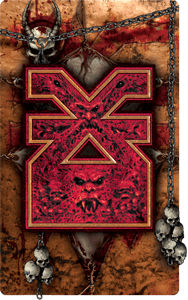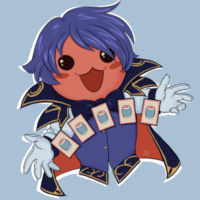Maximizing the number of skulls for the Skull Throne.
Khorne
Chaos cards: Battle Cry x4, Blood Frenzy x4, The Blood God's Call x3, Field of Carnage x3, Reborn in Blood x3, Ritual Slaying x3, The Skull Throne x4; total deck cost: 26
Expansion Chaos cards: Bloodbath x4, Hate x3, Lambs to the Slaughter x4, Lure of Battle x2, Rampage x4, Skulltaker x4, Terror x3; total deck cost: 27
Upgrades: Bloodletters, Bloodsworn, Bloodthirster, Deluge of Ferocity, Power of Blood
Expansion Upgrades: Bloodletters, Bloodsworn, Bloodthirster, Crimson Tide, Vengeance
Figures: 1 Bloodthirster, 6 Bloodletter Warriors, 4 Bloodsworn Cultists
Dial: Score 4 VP; Upgrade Card; Draw 2 Chaos cards; Score 4 VP; Upgrade Card; Upgrade Card; Draw 2 Chaos cards; Draw 2 Chaos cards; Khorne Victory!
Khorne is the god of war and, just from the figure count, you can see how that plays into the design. With the most Warriors in the game and the fewest Cultists, it's clear where your focus should be when it comes to playing the Blood God. That plays right into the dial advancement condition, as well, since "The sheriff" should be following the other players around and dishing out as much punishment as possible, not only to further their own ends toward victory, but to slow down the inexorable advance of everyone else. CitOW is unusual for a DoaM in that it allows the attacking player to select the targets for successful hits, so taking the initiative in seeking out battle can be beneficial for all players who are trying to either slow down their opponents' Corruption plans and/or trying to seize Domination for themselves. It ends up being doubly beneficial for Khorne, simply from succeeding in those aims but also in advancing their dial as fast as possible. Among the five gods, Khorne players are one of two who can be most forgiven for focusing on only one of the two victory conditions (the dial; like Nurgle is for VPs), as its play is clearly slanted in that direction. However, one can't completely neglect the other avenue as, with opponents' Cultists frequently dying at the hands of the Blood God's minions, it's not unusual for Khorne to be building up the most Corruption in certain regions over the course of a few rounds and often Dominating those regions, as well. Khorne also has the most up-front VP gain from their dial. While three gods equal his total (8) and Nurgle eventually exceeds it (9), only Khorne gets such a burst of VP from dial ticks, at 4 each, so early in the game, although others get a larger burst late.
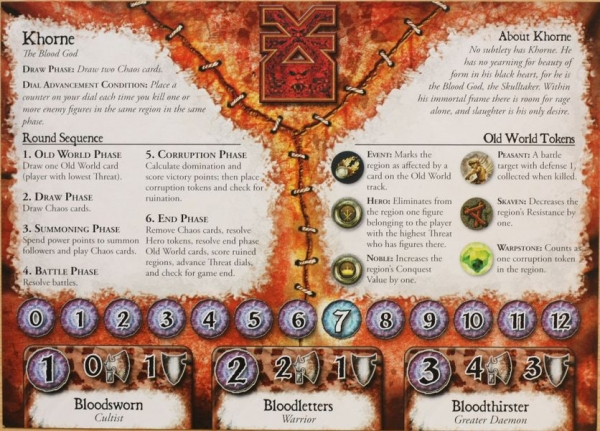
But a common complaint about Khorne is how quickly that dial victory can be achieved. An equally common mistake is thinking that Khorne has an advantage based on the dial ticks required, but the Blood God's is actually the second-longest in the game at 9, with Nurgle coming behind him at 10, both Tzeentch and Horned Rat coming in before him at 8, and Slaanesh beating everyone at 7. The proper direction of the complaint is the greater ease with which Khorne can achieve the most advancement tokens with good die rolls, often guaranteeing two ticks per round while everyone else has to meander along at one per. However, that also means that the sheriff is subject to the law of the dice. I've seen just as many games where Khorne players can't roll above a three and get stonewalled through no fault of their own, as I have when they can't seem to roll anything but a 6 and more of them on the exploding bonus rolls. That's where a canny Blood God player starts angling for some good Ruination scores and takes advantage of the aforementioned VP burst off those first few dial ticks and perhaps steals a win via the back door.
Figures and Upgrades
Khorne is the only god with Warriors that have an attack value of 2 and is also unique in the ability to grant an attack value of any kind to their Cultists. They also have twice the number of Warriors as anyone but Nurgle. That makes Khorne the offensive force that you'd expect them to be. However, despite popular opinion that the Bloodsworn upgrade is automatic for Khorne players, since it only enhances the number of regions and amount of dice that they can roll at any given time, part of the challenge of playing Khorne is in getting your guys where they want to go. You're going to be spending a lot of Power points on creating chains to other regions that are target-rich environments. In that respect, if you can camp out in a region or two (especially Populous ones, since you know that Nurgle will want to be there, by default) and not have to spend Power on making those chains, the Bloodletter upgrade, which lets you complete combat before anyone else can roll, can sometimes be the better option. In that respect, you remove enemy Warriors before they get a chance at your Bloodletters, which can help to keep your costs down. That said, the Bloodsworn upgrade is still excellent because it increases your overall Battle dice and your Cultists still drop Corruption. Of course, considering the excellent selection of Chaos cards that Khorne has, Deluge of Ferocity is a welcome change at any time, especially if you're competing with Tzeentch over card slots (and, if Tzeentch is being played well, you should be.) Similarly, Power of Blood is never a bad idea, although it's not quite as important as it often is for other gods, since Khorne is the only one who starts with 7 Power, rather than 6. But, again, if you're in a situation where you're constantly re-summoning to reach targets, PoB can be helpful. The Bloodthirster, in contrast, is often more of a "win more" unit. It is an impressive 4 dice in attack all by itself, but if your Bloodletters are positioned appropriately, it can turn into overkill. However, its upgrade does steer you back toward a points win, so if you find yourself having trouble getting advancement tokens, the Bloodthirster can go a long way toward pushing you past your opponents on the VP track.

The expansion upgrades, like the expansion Chaos cards, push Khorne strongly in the direction of a points/Domination/Ruination approach to victory. The mild exception is Vengeance, which would have been an almost automatic pick in the base set, since it increases your battle dice wherever you're rolling. I think it was included here to keep a foothold in that original strategy. Again, the Bloodletters upgrade may be the best of the lot, since you can often gain a fistful of VPs by using your Warriors the way you almost always will. The Bloodsworn upgrade is less so, since it certainly contributes to Domination but, as with the base set upgrade, you're talking about an improvement to only 4 figures. It does tie in with Crimson Tide, though, since it will be easier to take advantage of the latter with increased Domination, but that one has always struck me as a bit too situational. In contrast to the base set, though, the Bloodthirster upgrade from the expansion can be an enormous swing in the second half of many games, since dropping one in for 0 Power and then clearing out virtually all the enemy Cultists to gain a Domination/Ruination edge is a very viable approach.
Chaos Cards
In my experience, the most impactful cards for Khorne are The Blood God's Call and Field of Carnage. The former immediately moves two figures (i.e. Bloodletters) to a region at the cost of only 2 Power points and requires no adjacency to do so, while the latter prevents anyone from leaving the region, which means your targets can't flee even after you move in. Since the Blood God will always be first in the Summoning phase, this often guarantees you either a rich harvest of bodies or someone having to play a card that cancels Field in the other slot, if it's open. Moving around the map and preventing others from moving away are key aspects of Khorne's play. Similarly, Reborn in Blood and Battle Frenzy ensure that you do what you do best, which is kill things, since you'll have two complete Battle phases in the region and/or get to roll two dice before Battle to try to clear out enemy Warriors and preserve your Bloodletters for next round; on top of simply rolling two more dice to ensure a steady stream of advancement tokens. One thing to keep in mind, though, is that you only need to have one more token than your opponents to get the two ticks on the dial. If you can assess what they will be capable of that round and find that you have enough battle opportunities to get that token lead, you shouldn't hesitate to play other things that can be useful.

One of those things is Ritual Slaying, which can send a stream of Chaos cards into your hand. None of the cards in Khorne's set cost more than 2 Power points, so having a hand full of cards is often a huge advantage. One of those cards is The Skull Throne, which can make up for the fact that your cards are so cheap, as it typically enhances the Domination value of your figures (read: Bloodletters) and lets you stay in the running for a VP victory. Meanwhile, Battle Cry brings opponents' Ruination plans to a halt by preventing Corruption in that region from happening at all. Combining that with Field of Carnage can be utterly demoralizing for an opponent who has a significant number of now almost-useless Cultists trapped there.
Expansion Chaos Cards
The most similar cards in Khorne's expansion deck to the base cards are Hate and Rampage, as the former functions largely like Field of Carnage, forbidding opponents from moving, and Rampage is like Reborn in Blood, since a battle is immediately conducted when it's played. However, a key difference for Hate is that Khorne can place their own figures on the card and forbid them from leaving, as well, which means that many of the effects of one's opponents won't be able to change the Blood God's potential Domination or Ruination of the region in question. Right in that (ahem) vein is Lure of Battle, the most expensive card in either deck for Khorne. However, it's also reduced in cost for every Cultist present, which means a potential huge lift to Domination, as the base value remains 4, regardless of what it cost to play it. Staying in the movement theme are Terror and Lambs to the Slaughter, which allow you to move figures out of or into that region, depending on what Khorne's plans may be or what the Domination/Corruption situation may look like. If you have enough Bloodletters (or a Bloodthirster) present and have access to the second card slot, a great follow-up to Lambs is Bloodbath, which gives Corruption for every kill inflicted. Following Domination with the Ruination points AND scoring for the most Corruption can be a game-ending move in the later rounds. The final great combo piece to that puzzle is Skulltaker, which gives another great boost to Domination attempts, pending Battle results.

The most important aspect to Khorne's play is the sense of threat to your opponents. Not necessarily Threat, as in the value on the dial, although that can be important, but how threatening you are to the regions that they'd like to have a presence in. Again, that's why Khorne is the sheriff. If Nurgle builds up too many Cultists in Estalia, you can be sure that Khorne will be summoning there as soon as possible to take advantage of all of the weak targets that will also put a dent in Nurgle's dial token plans. In that respect, Nurgle is the easiest of targets because you always know the four regions that the Plague Lord will be focusing on and they won't shift around the map. But Nurgle is also frequently the slowest to develop, so taking advantage of the easy Leper targets may be making it easier for the other players to slip past you. Khorne should be an equal opportunity menace. Almost as tempting a target is the Horned Rat, since it relies upon Clanrats to be present in order to participate in Corruption. No one else can so easily have Corruption/Ruination plans disrupted by a few good rolls by some Bloodletters. But it also means getting to where the Rats would like to be, which is generally around Skaven tokens. That brings up the necessity of convenient movement for Khorne again. The Bloodsworn in that respect are, like so many things in this amazing game, on a knife's edge of utility. As noted earlier, you do want to take advantage of regions that can be Dominated and you do want to be in on Ruination scores if you can make it happen. But the Bloodsworn are just as, if not more, useful as adjacency targets that will make it easier for Bloodletters to get around the map, since it costs you 2 Power points to do so every time you want to move one of the horned monsters. This changes, of course, with the expansion card set, where you'll most often be using your Warriors to set up good conditions for regions with multiple Bloodsworn in them. But as with most aspects of CitOW, being flexible to game conditions is the most important aspect of any god's play. With Khorne, you're almost always the protagonist in the early and mid-game, so the play of others will, to one degree or another, orbit around you. How you exploit that will determine how quickly you turn the Old World into a pile of skulls. Next time, we turn to the depredations of Papa Nurgle.
 Games
Games How to resolve AdBlock issue?
How to resolve AdBlock issue? 